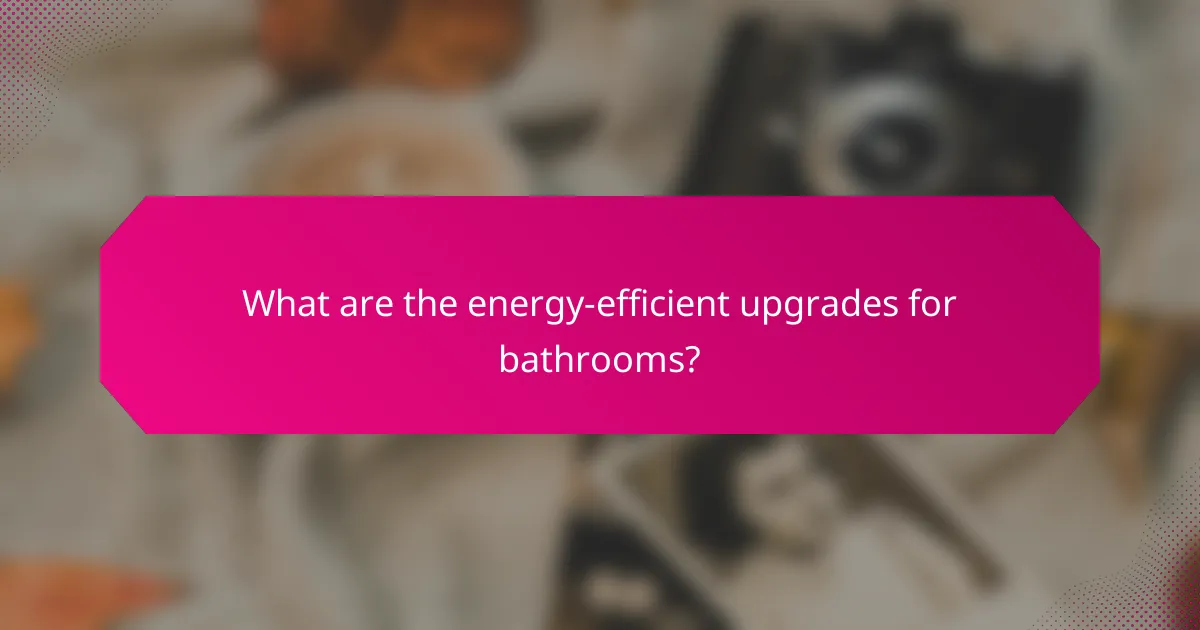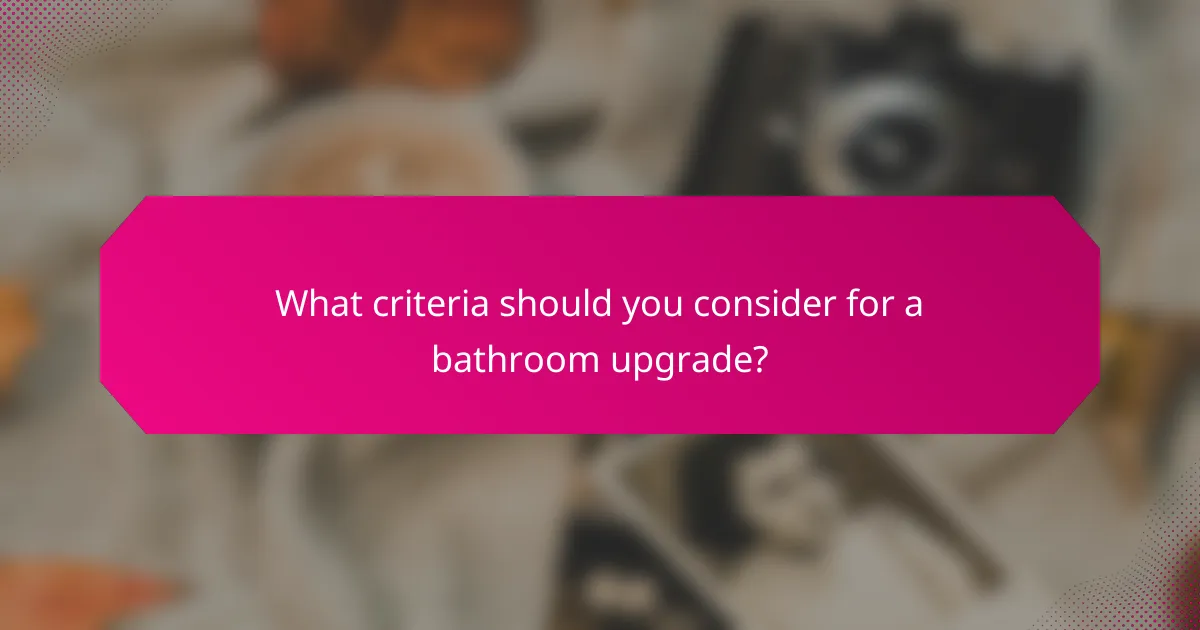Upgrading your bathroom can transform it into a sanctuary of comfort, energy efficiency, and stylish design. By incorporating features like heated flooring and luxury fixtures, you can create a relaxing atmosphere while also reducing utility costs. Embracing current trends allows homeowners to achieve a harmonious balance between aesthetics and functionality, making their bathrooms both beautiful and sustainable.

How can you enhance comfort in your bathroom?
Enhancing comfort in your bathroom involves integrating features that promote relaxation and ease of use. Key upgrades include heated flooring, ergonomic fixtures, luxury showerheads, soft-close toilet seats, and comfortable seating options.
Heated flooring systems
Heated flooring systems provide warmth underfoot, making your bathroom feel cozy, especially during colder months. These systems can be electric or hydronic, with electric mats being easier to install in smaller spaces.
Consider installing heated floors in areas where you spend the most time, such as near the shower or bathtub. The installation cost can vary, but many homeowners find the comfort and energy efficiency worth the investment.
Ergonomic fixtures
Ergonomic fixtures are designed to enhance usability and comfort. Look for faucets and shower controls that are easy to operate, even with wet hands, and consider height-adjustable showerheads for a more personalized experience.
Choosing fixtures with lever handles instead of knobs can also make a significant difference, especially for individuals with mobility challenges. Ensure that all fixtures are installed at a comfortable height for all users.
Luxury showerheads
Luxury showerheads can transform your daily routine into a spa-like experience. Options include rain showerheads, handheld models, and multi-function designs that offer various spray patterns.
When selecting a showerhead, consider water efficiency ratings to balance luxury with sustainability. Many modern showerheads provide a satisfying experience while using less water, helping to reduce your utility bills.
Soft-close toilet seats
Soft-close toilet seats prevent slamming, providing a quieter and more gentle experience. They are designed to close slowly and quietly, which can be especially beneficial in shared bathrooms.
When upgrading, look for seats made from durable materials that are easy to clean. Some models even come with added features like built-in night lights or heated options for extra comfort.
Comfortable seating options
Incorporating comfortable seating options, such as a bench or stool, can enhance the functionality of your bathroom. This is particularly useful for larger bathrooms where you can create a dedicated space for relaxation or dressing.
Choose materials that are water-resistant and easy to maintain. Consider adding cushions or throws for added comfort, and ensure the seating is positioned conveniently for daily use.

What are the energy-efficient upgrades for bathrooms?
Energy-efficient upgrades for bathrooms focus on reducing water and electricity consumption while enhancing comfort and style. Implementing these upgrades can lead to significant savings on utility bills and a more sustainable living environment.
Low-flow faucets
Low-flow faucets are designed to reduce water usage without sacrificing performance. These fixtures typically use less than 1.5 gallons per minute (GPM), compared to standard faucets that can use over 2.2 GPM.
When selecting low-flow faucets, look for models that are WaterSense certified, ensuring they meet efficiency standards. Installing aerators can also help achieve lower flow rates while maintaining water pressure.
Energy-efficient lighting
Energy-efficient lighting options, such as LED bulbs, consume significantly less electricity compared to traditional incandescent bulbs. LEDs can use up to 80% less energy and last up to 25 times longer, making them a cost-effective choice for bathroom lighting.
Consider using dimmable LED fixtures to create ambiance while further reducing energy consumption. Additionally, incorporating natural light through windows or skylights can enhance the overall brightness of the space without relying solely on artificial lighting.
Smart thermostats
Smart thermostats help regulate temperature in your bathroom efficiently, adapting to your schedule and preferences. These devices can learn your habits and adjust heating or cooling accordingly, potentially reducing energy usage by 10-15%.
When choosing a smart thermostat, ensure compatibility with your existing heating system and consider features like remote access via smartphone apps. This allows you to control the temperature even when you are away from home, optimizing energy savings.
Water-saving toilets
Water-saving toilets use significantly less water per flush compared to traditional models, typically around 1.28 gallons per flush (GPF) or less. This can lead to substantial water savings over time, especially in households with high usage.
Look for toilets that are WaterSense certified, which indicates they meet strict efficiency guidelines. Dual-flush options are also available, allowing users to choose between a lower volume flush for liquid waste and a higher volume flush for solid waste, maximizing water conservation.

Which stylish designs are trending in UK bathrooms?
Current trends in UK bathrooms emphasize a blend of comfort, energy efficiency, and stylish design. Homeowners are increasingly opting for designs that not only look good but also enhance functionality and sustainability.
Minimalist aesthetics
Minimalist aesthetics focus on simplicity and functionality, creating a serene bathroom environment. This design often features clean lines, neutral color palettes, and uncluttered spaces, which can make small bathrooms feel larger.
To achieve a minimalist look, consider using wall-mounted fixtures and built-in storage solutions. This approach reduces visual clutter and promotes a sense of calm, making your bathroom a relaxing retreat.
Bold tile patterns
Bold tile patterns are making a statement in UK bathrooms, adding personality and flair. Geometric shapes, vibrant colors, and intricate designs can transform a standard bathroom into a stylish focal point.
When incorporating bold tiles, balance them with more subdued elements to avoid overwhelming the space. For instance, use patterned tiles on a feature wall or as a backsplash while keeping the rest of the decor neutral.
Freestanding bathtubs
Freestanding bathtubs are a popular choice for creating a luxurious feel in the bathroom. These tubs come in various shapes and styles, from modern to vintage, allowing homeowners to express their personal taste.
When selecting a freestanding bathtub, consider the size of your bathroom and the overall design theme. Ensure there is enough space for comfortable movement around the tub, and think about the plumbing requirements, as some models may need additional adjustments.
Natural materials
Natural materials are increasingly favored for their aesthetic appeal and sustainability. Wood, stone, and bamboo can bring warmth and texture to bathroom spaces, creating a connection to nature.
Incorporating natural materials can be as simple as choosing wooden cabinetry or stone countertops. Ensure that materials are properly treated for moisture resistance to maintain durability and prevent damage over time.

What criteria should you consider for a bathroom upgrade?
When upgrading your bathroom, consider factors such as budget, space planning, and style preferences. These criteria will guide your decisions and help create a comfortable, efficient, and visually appealing space.
Budget considerations
Your budget is a crucial factor in any bathroom upgrade. Determine how much you are willing to spend, keeping in mind that costs can vary significantly based on materials, fixtures, and labor. A typical bathroom remodel can range from a few thousand to tens of thousands of dollars.
To manage expenses, prioritize your needs versus wants. For instance, you might opt for mid-range fixtures instead of luxury brands to stay within budget while still achieving a stylish look. Consider potential savings from energy-efficient appliances, which can lower utility bills over time.
Space planning
Effective space planning maximizes functionality and comfort in your bathroom. Assess the current layout and think about how you use the space. Consider whether you need additional storage, a larger shower, or a double vanity to accommodate your needs.
Use design software or consult with a professional to visualize different layouts. Remember to account for necessary clearances around fixtures and ensure that the flow of movement is intuitive. A well-planned space can significantly enhance your bathroom experience.
Style preferences
Your style preferences will define the overall aesthetic of your bathroom. Consider the existing design of your home and choose a style that complements it, whether it’s modern, traditional, or a blend of both. Look for inspiration in magazines, online platforms, or showrooms.
When selecting colors, materials, and fixtures, aim for a cohesive look. For example, if you choose a contemporary style, opt for sleek lines and minimalistic designs. Balancing personal taste with practical choices will result in a bathroom that is both stylish and functional.
